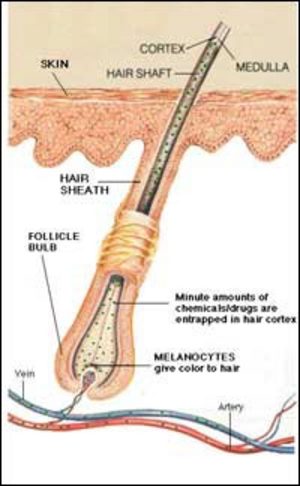A form of pre-employment drug screening has become increasingly popular in the past few years: hair testing. This testing is also used in limited ways to determine drug use during probationary periods or rehabilitation. Although it is more accurate at detecting drug use than urinalysis tests, this type of screening carries problems of its own.
Hair testing is prized by many companies because of its ability to detect drug use for longer periods in the past. Urinalysis tests are limited because of certain limiting factors relating to the drugs themselves. Most drug metabolites are excreted from the body within a few days at most, with a few exceptions. Marijuana is one of the exceptions, as it can remain in fat cells of the human body and be detectable in urine for up to thirty days after use. Still, many other factors such as metabolism, daily hydration, and exercise can cause this time to vary significantly.
Hair testing can allow employers to see much more deeply and accurately into the drug use of their employment candidates’ past. Hair is grown out of a follicle, where blood vessels surround fatty deposits and nourish the root of the hair. After drug use, metabolites float through the bloodstream and end up in the follicle vessels. The drug metabolites are then trapped in the inner core of the developing hair, surrounded by keratin protein. Thus, the metabolites are preserved inside the hair, like the rings of a tree. The metabolites will remain in the hair for as long as that particular segment is attached to the head. And not just marijuana and fat-soluble metabolites are trapped, all drug metabolites are.
Because metabolites are trapped and preserved INSIDE the hair strand, it is very difficult for someone to try and beat the test. With urinalysis tests, the subject being tested can do something as simple as drink a lot of water before the test in order to skew the results. With hair tests, there is little, if anything that can be done other than removing the affected hair prior to the test. Special hair treatment shampoos and preparations are advertised on the internet, but there is little evidence to conclude that any of these treatments are effective in removing the metabolites. Simply washing the hair will not remove the metabolites which are inside the inner layers of the hair strand. Also, even if a subject shaves his or her head, any hair can be used from the body in order to yield results. And since the metabolites come from the bloodstream circulating through the entire body, there is an equal chance that they will be preserved in arm hair as they will be in scalp hair.
Hair testing kits are different from urinalysis tests because drug use cannot be determined onsite. A nurse or other person removes a lock of hair a minimum of an inch long and a quarter centimeter thick. The hair is then placed in packaging and sent to the testing kit’s company lab. The laboratory digests the hair and runs a test similar to gel electrophoresis in order to determine the presence of drug metabolites as well as the time they appeared in the bloodstream. The results are then sent to the employer within a couple of weeks.
Hair testing, though effective at determining when someone has done drugs, has many of the same flaws as other drug tests. Alhough hair testing can determine the presence of metabolites, it does not distinguish between many false positives. For example, dextromethorphan from cough syrup can cause false positives for amphetamine use. Also, there is the question of how long of a time period the lab and the employers take into account. In general, laboratories claim that they only use the previous three months as a range for drug screening. If someone has smoked a joint three months ago, does that really mean that they will be smoking on the job or that their job performance will be affected by that distant episode of use? Finally, although hair testing claims to be a non-invasive method of drug screening, this isn’t entirely the case. After personally enduring a hair test, I left the doctor’s office with a chunk of hair the size of a postage stamp missing from the back of my head. I fail to see how walking around with that much hair conspicuously missing from the back of my head was non-invasive.
Hair tests are certainly more effective at screening for drugs than urinalysis. However, the question remains whether or not they are accurate indicators of an employee’s competence or suitability for a responsibility or position.





